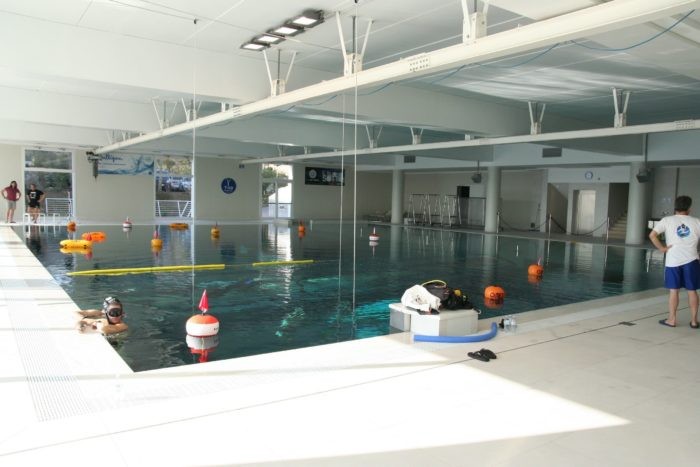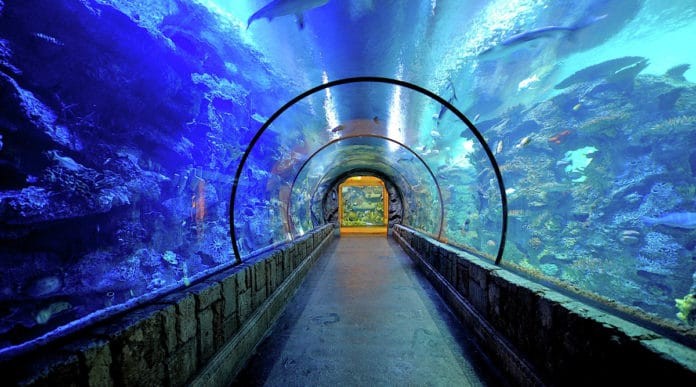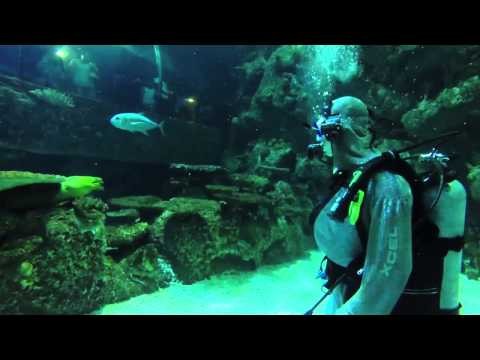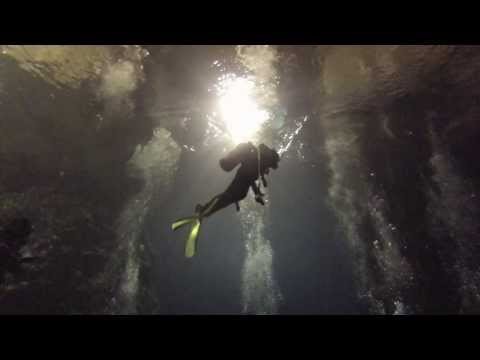Many of us first experienced scuba diving indoors. In many colder climates, the confined water elements of our training may have been held in an indoor swimming pool. Even if it was done outdoors in a pool it was still a confining space. According to PADI:
“Confined water is a general term that refers to either a swimming pool or confined open water. Confined open water is an open water site that offers swimming pool-like conditions with respect to clarity, calmness, and depth. It has both shallow water and water sufficiently deep to allow student divers to meet all skill performance requirements.”
I do not think that after our initial training, there are many of us that look forward to diving indoors or the typical confined open water. Here are four sites that I will suggest that will change your idea of what diving indoors is about. Some of these might stretch the definitions a little bit, however, they are all worthy dives.
Indoor Swimming Pool – Y-40 At The Hotel Terme Millepini
You just checked in to the Hotel Terme Millepini located in Montegrotto Terme about a 45-minute drive from Venice. You cannot wait to get your dive vacation started so you jump into your bathing suit, grab your dive gear and head towards the hotel’s heated indoor swimming pool. I am sure I heard a few yawns out there. Big Deal, diving in the hotel pool. Well, this pool is a little different. First, it is a thermal pool, and yes many spa resorts have thermal pools. However, the hotel pool at Hotel Terme Millepini holds a Guinness world record. This pool called the Deep Joy or Y-40 is the world’s deepest pool. Measuring 21X 18m on the surface, the pool water temperature is a constant 32-34c and reaches down to 40 meters deep.

In the photograph, you should notice some buoys with numbers on them floating in the pool. These buoys are tethered to the bottom of the pool at different depths. The numbers represent the depths. While the pool is 21 meters by 18 meters at the surface there is a platform at 5 meters, the platform reduces the opening but does allow divers to continue down to other platforms at 10 meters, 15 meters, and 20 meters. Each platform decreases the space of the opening continuing down. At the 20 meter mark, a cylinder shape remains that drops strait down another 20 meters to a large Y-40 painted on the bottom. The cylinder has marker lights ever one meter to help orientate the divers. The constant water temperature, lack of current and marine life can make it difficult to measure your descent without them.
The platforms are also interesting as some of them have passageways to mimic caves. The pool also has windows. Visitors can view the pool from the lounge where the pool is about 5 meters deep, or walk in a glass tunnel from one side to the other.
Y-40 is very popular not only for scuba divers but also for free divers. Training is available for both scuba and free divers.
30 Sharks Guarantee
Diving with sharks is an adventure that many divers seek out. However, they are a wild creature and while we may know where they hang out, it is no guarantee that they will cooperate. If you really want to see sharks up close than head to Vegas Baby! The Shark Reef Aquarium at Mandalay Bay has a dive experienced that is hard to beat if you are a shark lover. According to their website:
“Shark Reef Aquarium is an exciting journey through a slowly sinking temple overcome by some of the most dangerous predators in the world. View a diverse cross-section of magnificent aquatic creatures, including 100 sharks, (15 species in all) along with exotic fish, reptiles and sea turtles. Featuring more that 2,000 animals, Shark Reef Aquarium is comprised of nearly 1.6 million gallons of water in 14 exhibits, including rare Golden Crocodiles, Piranha, a Touch Pool Experience and over 30 sharks in our 1.3 million gallon Shark Exhibit. Guests also experience two walks through tunnel exhibits giving a “diver’s view” of the underwater world.”
The shark dive experience takes place in the Shipwreck Exhibit. The exhibit has 30 sharks of seven species. These include Sand Tiger Sharks, Galapagos Shark, Sandbar Sharks, Gray Reef Sharks, White Tip Reef Sharks, Nurse Sharks and Zebra Sharks. There are also a few cousins, Southern Stingrays, and Green Sawfish. The divers, up to two, and up to four guests are given a VIP tour of the aquarium that includes behind the scenes. After the tour, the guest goes to a public viewing area while the divers go to prepare. The divers are given complete instructions on how the dive will be conducted as well as extensive safety information.
Divers are not allowed to bring in their own equipment. This is done to eliminate the risk of potential contamination. Personal masks are allowed but are soaked in a chlorine solution before use. The equipment provided the diver includes chain mail. This is a portion of the safety requirements. The dive requires you to be alert at all times so cameras are also not allowed. However, the entire experienced will be capture on video by one of the staff divers.
The dive is done in the Shipwreck Exhibit so your non-diving friends and the general public will be watching you. It is a one tank dive with a 45 minute limit on bottom time.
This may also be the most expensive shallow dive in the world. To make this dive you must be staying in the Mandalay Bay hotel. The cost for the dive itself is $650 for one diver or $1,000 if two divers book together.
Titan Missile Silo
If Mandalay Bay seems like commercialism to you, here is a dark deep adventure back to the cold war. Royal City Washington is a small city of fewer than 3,000 people. Around it, you will find mostly open spaces, farm land, wildlife reserve and a national monument. Oh, and if you now where to look Titan 1 missile silos. Undersea Adventure Dive center in Kennewick Washington has leased a cold war Titan 1 Intercontinental Ballistic Missile (ICBM) complex and is using it for diving.
At the peak of the cold war, this complex was the home to three nuclear ICBMs. After the Titan missiles were decommissioned the complex was abandoned. Without the presence of man, Mother Nature reclaimed the silos. Ground water started to seep into the complex and today the lowest 100 feet is filled with water. The water temperature is around 50 degrees so cold water gear is needed. Also, there are no lights, so it is the ultimate night dive. Divers have to climb top from the top to the area being used as a ready room. From there it is a hike along partially submerged corridors until you reach the central portion of the silo and an area for your final equipment check.
Undersea adventures have these Prerequisites and Requirements to dive here:
- Advanced certification or higher required
- Photocopy verification of C Cards
- Recent Cold Water Dives
- Night Diving Light and backup
- Chem light or tank light
- Statement of Understanding
- Missile Silo Waiver
- Good physical shape – walk in is moderately difficult
The missile silo complex has a number of levels with offices and maintenance sections. Depending on your skill level you might be able to visit some of these. The water is clear and your light beam defines how far you can see. While the government took out much of the sensitive equipment and vandals ripped out items, there is still much of the original wiring and piping in place. Definitely a different type of indoor dive.
Bonne Terre Mine
Bonne Terre Missouri was once a mining town. A lead mine was opened there in 1860 and it continued until 1964 over a hundred years of moving ore. There were a number of lead mines in Missouri and also around the world, however, Bonne Terre produced more lead ore than any other mine. It also became the largest mine. It had five different levels when they stopped production. When the mine closed down and the pumps were turned off, water started to seep into the mine and filling it up. The lower three levels are now submerged and have become a 17-mile long lake. A lake littered with the tools of mining. Shovels, pick axes, ore carts and other tools were just left behind. The mine uses the phrase line of the Billion Gallon Lake. Tourist can visit the mine and walk along the tunnel in the upper two level. It is the lower levels that really sets this mine apart from other mines. The scuba diving.
The water stay at 58 degrees year-round and the visibility is over 100 feet, the three submerged areas mean the water is over 100 feet deep. There are 24 different trails that visit different portions of the mine. Diving is done in groups of 9 divers with 2 dive guides, one leading and one following. Only the guides have lights, but there is some light from the over 500,000 watts of stadium lighting that shine down into the water. Divers must do trail 1 and 2 before they would be considered to be allowed to dive some of the other trails. You may be in a mine but trail 1 and 2 are suitable for open water divers, you can even learn how to dive here. In addition to the in water guides, there is a kayak above the divers providing surface support.
From the outside, you really do not get a hint of what awaits you below. You enter the mine by entering the building that the miners used and then walk down to the mine areas. A Large platform gives you ample space to set up your gear and get ready. The ceiling is high above you so you do not feel closed in. 100-foot visibility no currents and a constant temperature sound great to me.
These four dive destinations are each different and feature something unique. Try something new in your diving this year.



